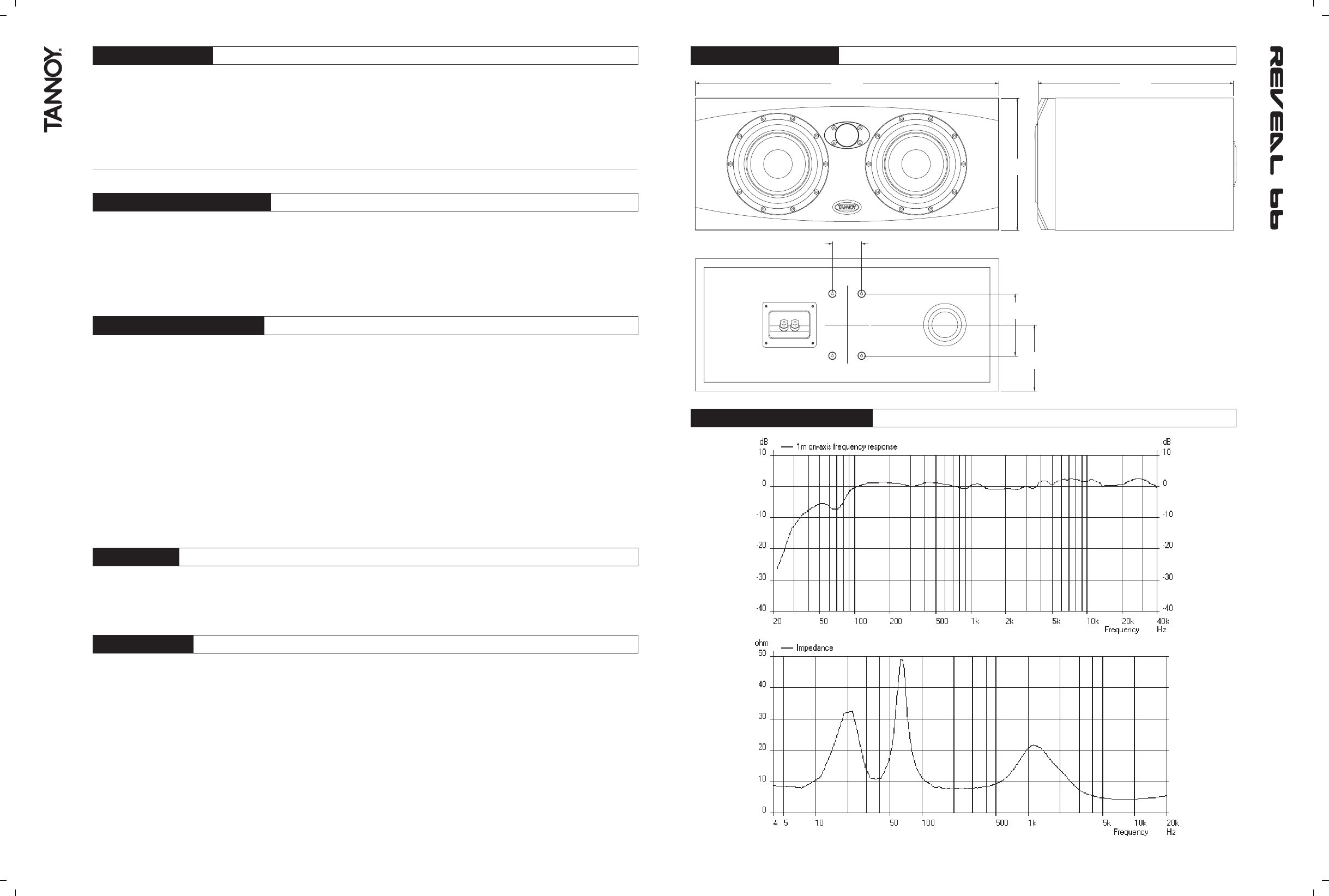
16 17
2.5: POWER AMPLIFIERS
The power amplifier should be reasonably well matched in power to the power rating of the speakers (see specifications). The
use of a powerful amplifier (i.e. in excess of the recommended figure) provides headroom, which is useful especially for highly
dynamic programme materials.
Due of the high peak power handling of Tannoy monitors, responsible use of even more powerful amplifiers should not represent
a danger to the speakers if the amplifiers are not overdriven.
3.1: 5.1 SURROUND MONITORING
In order to ensure a uniform acoustical environment, the room should be symmetrical about the centre loudspeaker axis; room
treatments should be applied symmetrically throughout the room. Mixed "Live end/Dead end" environments should be avoided.
If the lateral speakers are positioned close to walls then the constitution of the wall surfaces should be identical.
As the main effects speaker for the front soundstage, the Reveal 66's placement is a critical factor in its performance. In all cases
the centre channel speaker should be placed as close to the TV screen as possible. The viewing position when seated determines
the ideal mounting height, but in all cases this should be as close as possible to ear height, if this is not possible the monitor
should be tilted towards ear height in the mix position. The centre speaker should be positioned along the centre axis of the
picture and the left/right monitors just outside the picture, ideally the three front effects speakers would be placed with the front
baffles in line with the screen surface. If an acoustically transparent screen is used, the left/right monitors should be placed just
inside the edges of the picture. The surround speakers should be positioned at the same distance to the mix position as the main
front speakers. As the subwoofer/LFE channel only produces low frequencies it is difficult to localise its position by ear. As a result
it could effectively be situated anywhere in the room, though optimum performance will be gained by placing the subwoofer in
the same plane as the main front speakers. The LFE channel is set at a level 10dB higher than the other channels when mixing
therefore it is important to apply the same in any playback situation.
3.0: INSTALLING AND POSITIONING
When choosing a suitable location for the monitors, bear in mind that the physical mounting of loudspeakers can have a large
influence on performance. For best results the monitors should be mounted on a rigid structure, supported on four pads making
contacts with the laminated panel. The use of soft pads (rubber, Sorbothane™, or Blu-Tak™) is recommended.
Ensure that the console position does not obscure the direct sound radiation from the loudspeakers when sitting down. The
engineer and producer should have a clear, uninterrupted view of the monitor loudspeakers.
3.2: BASS PORTS
The Reveal 66 monitors' bass port is located on the back panel. You should keep the back panels at least 150mm (6") away
from the nearest wall surface to avoid an overblown bass sound. If you cannot avoid being close to the wall you may want to
consider plugging the port tubes on your loudspeaker with a closed cell foam-rubber plug, friction fit for a full seal.
3.3: EQUALISATION
Our feeling is that you shouldn't equalise monitors at all; variations in the monitor response should be fixed through placement.
But we realise that equalisation is sometimes a necessary evil. If you have a choice of equalisers for monitor applications, less
is more. The fewer the number of filters, the better the equaliser will sound. A stereo five band parametric is better than a stereo
15 band that is better than a stereo 1/3 octave. You may not realise that in all but one or two brands of 1/3-octave equalisers,
all 30 filters are in series. There is a minimum transit time through each filter of some 25 microseconds, plus just a bit of decay
time for each filter. Even with the equaliser set flat, it does not behave like a straight piece of wire in the time domain. If you
don't need to equalise your monitors, then don't hook an equaliser up to them at all.
A subtle bit of reduction in the mid bass where the console or table top will give you a rise, perhaps a bit of tailoring to taste
here or there. As a general rule for this application, you should never need more than 6dB of control range, and you should
never see two adjacent filters with more than 6dB of difference between them. Over equalisation can reduce system headroom,
and introduce phase distortion resulting in greater problems than cures. Always check out the result of equalisation by listening
to well recorded vocals or speech.
4.0: REVEAL 66 DIMENSIONS
5.0: REVEAL 66 PERFORMANCE DATA
50.8mm
107.9mm
115.0mm
527.0mm 340.0mm
230.0mm
2”
9”
13
3
/8”20
3
/4”
4
1
/2”












